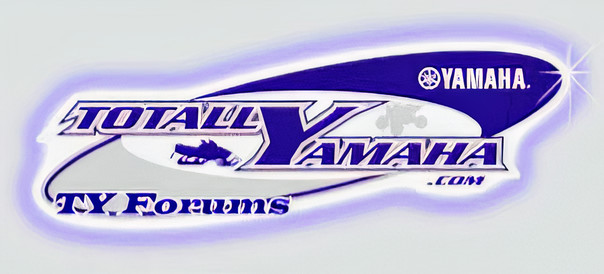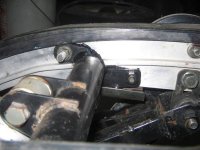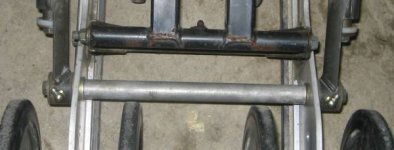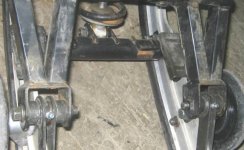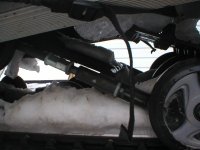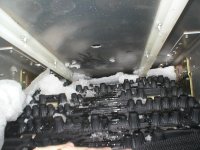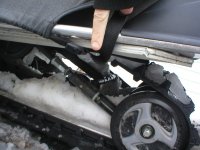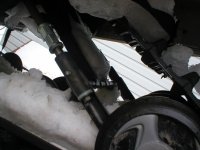First lets talk about what the parts of the pro action do. The most important part and weakest link, is the W arm. This part is what keeps the track running straight, tight, and on plain with the frame of the sled. It does this by holding the rails square and on plain the whole time your trying to beat the death out of your sled. All the power, breaking, track tension and bump absorption is transferred through this part and its bushings. When it is loose or damaged the shock can not control the movement correctly, the strap settings change, the track tension can change, the track can move from side to side under power, the skid can twist off plain causing the sled to lean as well as cause other damage if the problems are not corrected. This is just what is wrong with your skid from the day it was new.
A great way to find out what I’m talking about with your skid removed, loosen the straps so the sock can loosen up. When this is done, grab it and move it around. Now that you have done this, stop swearing and lets fix it.
Lets discuss the faults of the pro action skid or no action skid, as it has been branded. The W arm breaking is what always comes to mind when you think of a pro action. There are many thoughts on what breaks the W arm. The correct one I will discuss here and try to give you the many fixes that will cure it. I will list off the causes and repairs together below.
The W arm when it was new was poorly designed and after a few different versions has not been adequately updated yet. They are welded with too high a temperature causing undercutting of the weld. Paint falls off the welded area and rust eats away at the metal making it thinner in a line. The straps from the W arm Put constant downward pressure on the weakest point. Other contributing factors are spring pressure and bushing wear. These last factors we will deal with later.
To fix the W arm, clean all the paint off the welded areas. Then clean all the paint off the sides of the W arm(the side you would see from the side of the sled). Cut 2 pieces of 3/4in band iron that will go from the upper tube to the lower mount plate. Drill several 3/8 holes along the length of the band iron. Now spray weld coating on both pieces and the W arm. Now clamp in place. Check the W arm to see if it is on plane(sight across the upper tube to the lower mounts looking for twist). If it is off plane, twist it back before welding and check it while welding. Spot weld the holes and the ends. Weld over the factory welds even if they are not cracked making sure not to use too much heat and under cut the weld. Now sand the arm with a scotch brite and paint. There are stronger ways to fix a W arm but this will be more than enough after we address the other issues.
On to the next big engineering marvel that Yamaha actually paid people to design. The greaseless W arm mount. WHAT WERE THEY THINKING!!!! To fix this you will need two 1in long grease fittings. Drill and tap the brackets so that the fitting will extend straight up from the center.. Then thread in the grease fittings with locktite. Look inside the open end of the mount, if there is any of the fitting hanging down, use a dremel or file to smooth it out.

While you have the drill and tap out, install a 90* fitting in the lower pivot of the transfer rods. When you do this you will want to leave the fitting protruding into the tube a little. Then drill a corresponding hole in the bushing so the grease can get where it needs to be.

Back to the W arm. The upper shaft will show wear with almost no use. The bushings are loose on the shaft from the day it was new. Because it is loose, the grease gets pounded out of the gap. This also allows water to enter, reducing the lubrication even more. This is where the coffee can shim trick comes in. This trick works most anywhere on a Yamaha. I use this to tighten up all the bushings on my Yamahas. WOULD HAVE BEEN NICE IF YAMAHA HAD DONE IT TO BEGIN WITH. But, alas, here we go. Get a coffee can, tin snips, and a can of band aids. Cut the coffee can into strips ½ the distance around the bushing you want to tighten up. Make it as wide as the bushing(in the case of the lower W arm bushings make it wide enough to go from one side to the other). Then just insert the tin with the bushing. Insert the collar. If the collar is still loose you will need a bigger piece of tin. If it wont fit, cut a small strip off the tin and reinstall it. Keep doing this until the collar fits really tight. You will need to do this to the upper and lower W arm, lower transfer rods, upper transfer rods, and upper scissor. While your at it, do this trick to your radius rods and spindles.
Lets now address another reason someone at Yamaha should be fired. The front track shock doesn’t have any bearings or even a tight bushing. The bushings that come in the ends of the front shocks are very loose. Because they are loose, they will let moisture in, rust the collar and then the rust will really start to tear up the bushing. When this happens, it causes the shock to bottom out on its bumper after the W arm starts to bend around its bumpers. This in turn causes the W arm to flex back and forth. First down over the bumpers, then back the other way against the straps. You know what happens when you bend a piece of metal back and forth?? This effect is like using a shock that is wore out about 1/2in. Now honestly, would you install a shock that is wore out??
The fix for this problem is to install bearings. The rear shock has bearings(unless you have a xt, rx1 or any other gas bag shocked pro action). You will need to order two bearings, four plastic washers, four seals, and two short collars(upper mount end) from the dealer. Use any year srx to look it up. Go to the rear shock parts breakdown. Now that you have them, you will also need a set of feeler guages. Slide the bearing dry into the end of the shock. Now slide a feeler guage in between the bearing and shock.(.005 usually works) When you find one that fits tight, pick the next one thicker. Press the bearing in with the feeler guage and locktite leaving the feeler guage sticking out on each side. Grease the bearing and press the seals in. Using a new blade on a sheet rock knife, cut the feeler guage ends off by shaving against the shock. Install the collars and plastic washers and install in the skid. You will need to pry the mounts apart a little for the wider collar to fit in.
Flip the skid upside down, inspect the condition of the lower shock mount. if it is cracked, remove and reweld. When installing these I run a grinder over the end of the shaft, clean the rail good, mix up some jbweld and spread a thin layer over the ends of the shaft. Quickly bolt the mount in and tighten lightly, let dry, locktite and tighten. What this does is fills in any imperfections between the rail and mount so that it will fit tighter with no gaps. this part in conjunction with the W arm is what keeps your skid square and on plain. It also takes the twisting load from the front shock. It is very important this part fit as tight as it can. If it breaks, the bottom of the shock will break off and ruin the track. Another upgrade for this mount if your doesn’t have it already is to purchase the long bolt and nut like comes on newer pro actions. It is less likely to break off than the two bolts. If you want to overbuild this part you can add another bracket to bolt to the rail like below.

Now that you have fixed all that mess you will need to do many adjustments. Your old settings were to wore out parts. For example, the gap was on your transfer rods before, they are now tighter because your not adding all the slop into the total gap. Once you get it set up you will find now that the sled handles stutters better because the front shock is now allowed to work, where before it was just smacking around in all the loose bushings. Your sled will also handle flatter in the corner than it did. Making the skid tight is like adding a sway bar to the rear. In some cases, you will notice the sled is faster, and or rolls easier. This depends on the sled. Some sleds with a wore out skids will cause the track to jam to the side under load. When you adjust it in the shop it looks like it is centered. Under load this is not always true. Now that it is tight, the skid cant move from side to side.
Good luck and always use locktite.
Directions for installation:
loosen drive shaft bearing set screws
back off the transfer rod lower bolts 3/8in
back off rear idler adjustment all the way, move axle ahead and tighten axle bolts.
put fra adjuster in the soft/upper setting.
lift sled so that the front shaft will just fit under the fram next to the drive shaft
then slide the front into the track so it is headed tward center
now reach through the track and pull the skid tward you while lifting it up and down
lower rear of sled while holding back on skid to pull it behind the drive shaft
now install the front bolts, dont tighten
now go to the rear bolts, lower the sled onto them(two putty knives help to guide it past the inner braces)
install these bolts, dont tighten
now lift the back of the sled, the weight of the suspenion will lift the center/fra shaft into place, you may need to wiggle it a bit to get it up past the rivots(this is the reason for not tightening any bolts and loosening the bearing locks)
now tighten all suspension bolts
lock tight and tighten the bearing set screws
tightening the supsenion first will make sure that the bearing has no side load on it.
A great way to find out what I’m talking about with your skid removed, loosen the straps so the sock can loosen up. When this is done, grab it and move it around. Now that you have done this, stop swearing and lets fix it.
Lets discuss the faults of the pro action skid or no action skid, as it has been branded. The W arm breaking is what always comes to mind when you think of a pro action. There are many thoughts on what breaks the W arm. The correct one I will discuss here and try to give you the many fixes that will cure it. I will list off the causes and repairs together below.
The W arm when it was new was poorly designed and after a few different versions has not been adequately updated yet. They are welded with too high a temperature causing undercutting of the weld. Paint falls off the welded area and rust eats away at the metal making it thinner in a line. The straps from the W arm Put constant downward pressure on the weakest point. Other contributing factors are spring pressure and bushing wear. These last factors we will deal with later.
To fix the W arm, clean all the paint off the welded areas. Then clean all the paint off the sides of the W arm(the side you would see from the side of the sled). Cut 2 pieces of 3/4in band iron that will go from the upper tube to the lower mount plate. Drill several 3/8 holes along the length of the band iron. Now spray weld coating on both pieces and the W arm. Now clamp in place. Check the W arm to see if it is on plane(sight across the upper tube to the lower mounts looking for twist). If it is off plane, twist it back before welding and check it while welding. Spot weld the holes and the ends. Weld over the factory welds even if they are not cracked making sure not to use too much heat and under cut the weld. Now sand the arm with a scotch brite and paint. There are stronger ways to fix a W arm but this will be more than enough after we address the other issues.
On to the next big engineering marvel that Yamaha actually paid people to design. The greaseless W arm mount. WHAT WERE THEY THINKING!!!! To fix this you will need two 1in long grease fittings. Drill and tap the brackets so that the fitting will extend straight up from the center.. Then thread in the grease fittings with locktite. Look inside the open end of the mount, if there is any of the fitting hanging down, use a dremel or file to smooth it out.

While you have the drill and tap out, install a 90* fitting in the lower pivot of the transfer rods. When you do this you will want to leave the fitting protruding into the tube a little. Then drill a corresponding hole in the bushing so the grease can get where it needs to be.

Back to the W arm. The upper shaft will show wear with almost no use. The bushings are loose on the shaft from the day it was new. Because it is loose, the grease gets pounded out of the gap. This also allows water to enter, reducing the lubrication even more. This is where the coffee can shim trick comes in. This trick works most anywhere on a Yamaha. I use this to tighten up all the bushings on my Yamahas. WOULD HAVE BEEN NICE IF YAMAHA HAD DONE IT TO BEGIN WITH. But, alas, here we go. Get a coffee can, tin snips, and a can of band aids. Cut the coffee can into strips ½ the distance around the bushing you want to tighten up. Make it as wide as the bushing(in the case of the lower W arm bushings make it wide enough to go from one side to the other). Then just insert the tin with the bushing. Insert the collar. If the collar is still loose you will need a bigger piece of tin. If it wont fit, cut a small strip off the tin and reinstall it. Keep doing this until the collar fits really tight. You will need to do this to the upper and lower W arm, lower transfer rods, upper transfer rods, and upper scissor. While your at it, do this trick to your radius rods and spindles.
Lets now address another reason someone at Yamaha should be fired. The front track shock doesn’t have any bearings or even a tight bushing. The bushings that come in the ends of the front shocks are very loose. Because they are loose, they will let moisture in, rust the collar and then the rust will really start to tear up the bushing. When this happens, it causes the shock to bottom out on its bumper after the W arm starts to bend around its bumpers. This in turn causes the W arm to flex back and forth. First down over the bumpers, then back the other way against the straps. You know what happens when you bend a piece of metal back and forth?? This effect is like using a shock that is wore out about 1/2in. Now honestly, would you install a shock that is wore out??
The fix for this problem is to install bearings. The rear shock has bearings(unless you have a xt, rx1 or any other gas bag shocked pro action). You will need to order two bearings, four plastic washers, four seals, and two short collars(upper mount end) from the dealer. Use any year srx to look it up. Go to the rear shock parts breakdown. Now that you have them, you will also need a set of feeler guages. Slide the bearing dry into the end of the shock. Now slide a feeler guage in between the bearing and shock.(.005 usually works) When you find one that fits tight, pick the next one thicker. Press the bearing in with the feeler guage and locktite leaving the feeler guage sticking out on each side. Grease the bearing and press the seals in. Using a new blade on a sheet rock knife, cut the feeler guage ends off by shaving against the shock. Install the collars and plastic washers and install in the skid. You will need to pry the mounts apart a little for the wider collar to fit in.
Flip the skid upside down, inspect the condition of the lower shock mount. if it is cracked, remove and reweld. When installing these I run a grinder over the end of the shaft, clean the rail good, mix up some jbweld and spread a thin layer over the ends of the shaft. Quickly bolt the mount in and tighten lightly, let dry, locktite and tighten. What this does is fills in any imperfections between the rail and mount so that it will fit tighter with no gaps. this part in conjunction with the W arm is what keeps your skid square and on plain. It also takes the twisting load from the front shock. It is very important this part fit as tight as it can. If it breaks, the bottom of the shock will break off and ruin the track. Another upgrade for this mount if your doesn’t have it already is to purchase the long bolt and nut like comes on newer pro actions. It is less likely to break off than the two bolts. If you want to overbuild this part you can add another bracket to bolt to the rail like below.

Now that you have fixed all that mess you will need to do many adjustments. Your old settings were to wore out parts. For example, the gap was on your transfer rods before, they are now tighter because your not adding all the slop into the total gap. Once you get it set up you will find now that the sled handles stutters better because the front shock is now allowed to work, where before it was just smacking around in all the loose bushings. Your sled will also handle flatter in the corner than it did. Making the skid tight is like adding a sway bar to the rear. In some cases, you will notice the sled is faster, and or rolls easier. This depends on the sled. Some sleds with a wore out skids will cause the track to jam to the side under load. When you adjust it in the shop it looks like it is centered. Under load this is not always true. Now that it is tight, the skid cant move from side to side.
Good luck and always use locktite.
Directions for installation:
loosen drive shaft bearing set screws
back off the transfer rod lower bolts 3/8in
back off rear idler adjustment all the way, move axle ahead and tighten axle bolts.
put fra adjuster in the soft/upper setting.
lift sled so that the front shaft will just fit under the fram next to the drive shaft
then slide the front into the track so it is headed tward center
now reach through the track and pull the skid tward you while lifting it up and down
lower rear of sled while holding back on skid to pull it behind the drive shaft
now install the front bolts, dont tighten
now go to the rear bolts, lower the sled onto them(two putty knives help to guide it past the inner braces)
install these bolts, dont tighten
now lift the back of the sled, the weight of the suspenion will lift the center/fra shaft into place, you may need to wiggle it a bit to get it up past the rivots(this is the reason for not tightening any bolts and loosening the bearing locks)
now tighten all suspension bolts
lock tight and tighten the bearing set screws
tightening the supsenion first will make sure that the bearing has no side load on it.
Last edited:
irondog rtx
New member
great post and ideas boy wish I would have know this five years ago thanks and keep the tricks acomeing cant wait to dump my mono skid for another always get charge out when people say how they like it is nice but not that nice kim
Any pics of what you suggested betheviper?
here are a few pictures i could find
one of the repair for the front lower shock mount, the other two are of places that grease fittings need to be added.
make sure that the little wires that go over the straps on the lower arm are intact. if they are not, drill and screw the strap in place on this shaft with the w arm not compressed. If these straps are alowed to twist on this shaft on a 121 sled they will come back and be shreded by the FRA.
one of the repair for the front lower shock mount, the other two are of places that grease fittings need to be added.
make sure that the little wires that go over the straps on the lower arm are intact. if they are not, drill and screw the strap in place on this shaft with the w arm not compressed. If these straps are alowed to twist on this shaft on a 121 sled they will come back and be shreded by the FRA.
Attachments
Last edited:
tripplec
New member
Good article but I wish there were a few more specific reference pictures. Maybe some can post some.
horkn
New member
amazingly the rear skid on our new to us this year 97 venture600 with near 6k on it, was 100% ok. no cracks, or anything.
I wonder if stuff has been replaced?
I wonder if stuff has been replaced?
136 skids don't have the issues that the 121 skids do with w arms. This is because the front of the skid doesn't bottom out on it. These skids come with softer center springs too so there is less stress on the lower shock mount.
Anyone who has done this fix or others please feel free to post any other tips, tricks, pictures of your rebuilds, before and afters etc.
Anyone who has done this fix or others please feel free to post any other tips, tricks, pictures of your rebuilds, before and afters etc.
horkn
New member
BETHEVIPER said:136 skids don't have the issues that the 121 skids do with w arms. This is because the front of the skid doesn't bottom out on it. These skids come with softer center springs too so there is less stress on the lower shock mount.
AHHHH!!!
I see. thanks!
Maybe the much maligned proaction skid is much better in 136" versions. It rides really nice for an 11 year old sled. ALthough I have yet to hit whoops at 40-60mph with 2 up on it....
The real test will be Feb 8th-10th weekend...
I added an update to check on the lower front shock mount above.
here are the part numbers for the shock bearing update and bushings for the W arm. the rest of the bushings in the skid can be reused and shimmed.
Qty Part Number Description Price Total
1 8CR-47465-00-00 upper W arm SHAFT
2 90381-19111-00 upper W arm BUSH,SOLID
2 90387-1009T-00 lower W arm COLLAR
4 90381-15112-00 lower W arm BUSH,SOLID
2 93315-21454-00 shock BEARING,CYLINDRICA
4 93109-14021-00 shock OIL SEAL,SDO-TYPE
4 90202-14226-00 shock WASHER,PLATE
2 90387-1007N-00 shock COLLAR
Qty Part Number Description Price Total
1 8CR-47465-00-00 upper W arm SHAFT
2 90381-19111-00 upper W arm BUSH,SOLID
2 90387-1009T-00 lower W arm COLLAR
4 90381-15112-00 lower W arm BUSH,SOLID
2 93315-21454-00 shock BEARING,CYLINDRICA
4 93109-14021-00 shock OIL SEAL,SDO-TYPE
4 90202-14226-00 shock WASHER,PLATE
2 90387-1007N-00 shock COLLAR
Dragin
New member
how does this fix apply to a Mountain Viper 144" do I need to re-enforce mine???
I dont know anything about mountain sleds. I would guess that the front track shock would need bearings and the bushings are probly the same. If you go ahead with a suspension rebuild, please add to this thread what you found on that model.
sockeyerun
Test Dummy
Just my skid out of my 02 700MM yesterday for first time since shortly after it was new(3100mi). All the skid shaft bushings looked good (compared to the new ones I had) except the bushings in the lower mounts to the front W arm, they were toast. There was also wear in the shock bushings and the bushings in the gold straps were worn. Basically everything that you can service with a grease gun was fine. The worn parts were from areas that are not. Hey BTV thanks for all your info., I will be adding zerks to the bottom mount. SOC
the gold straps can be changed out for srx/sx/xtc/viper style with bearings, pm me if you dont have any from a doner sled.
stretchSXV
New member
UGGGGHHHHH I hate my no action skid. I am lost when it comes to my rear skid in my 2004 viper. I bought it 2 yrs ago. Every year after the second ride it craps the bed. Last year I brought it back to the yamaha dealer i bought it at. They adjusted it and charged it under warranty. This year again after the second ride of the season it went to crap. When I put it on my trailer I noticed it sat real low. Transfer rods have a gap on top. When I sit on it the gap doesn't change? The track seems to close to the tunnel . I lift up on the bumper and let go and it goes right back down. I'm at the point now where I want to sell it and move on. Any help would be great. First sled I've owned so not good at working on them. If I had the cash I'd slap a M-10 in or sell it and go with something different which hurts b/c I love Yami just hate the skids. 
 I'm uploading pics right now.
I'm uploading pics right now.

 I'm uploading pics right now.
I'm uploading pics right now.stretchSXV
New member
stretchSXV
New member
 I can't understand why this happens every second ride. I love having my wife sitting on her Doo laughing at me as I tinker with the yamaha.
I can't understand why this happens every second ride. I love having my wife sitting on her Doo laughing at me as I tinker with the yamaha. 

please describe exaclty what the sled feels like when you sit on the sled.
also, it doesn't look like it is compressing any when you sit on it. I'm wondering if it is moving at all?
also, it doesn't look like it is compressing any when you sit on it. I'm wondering if it is moving at all?
stretchSXV
New member
No movement at all. I just went and sat on it and it didn't move. I also stood up on it and hopped up and down and again nothing. It feels like it is bottomed out? 
 If I lift up on the bumper it will move then.
If I lift up on the bumper it will move then.

 If I lift up on the bumper it will move then.
If I lift up on the bumper it will move then.